How To Grow Chinese Money Plant With Emily Cupit – ‘A Fantastic Houseplant For Beginners’

HOUSEPLANTS > PILEA-PEPEROMIOIDES

Elizabeth is a Permaculture Garden Designer, Sustainability Consultant and Professional Writer, working as an advocate for positive change. She graduated from the University of St. Andrews with an MA in English and Philosophy and obtained a Diploma in Applied Permaculture Design from the Permaculture Association.
Reviewed By COLIN SKELLY

Colin is a Horticulturist and Horticultural Consultant with experience in a range of practical and managerial roles across heritage, commercial and public horticulture. He holds the Royal Horticultural Society’s Master of Horticulture award and has a particular interest in horticultural ecology and naturalistic planting for habitat and climate resilience.
Contributions From EMILY CUPIT

Emily is a Gardening Writer, Photographer and Videographer from Derbyshire, UK. She is the Founder of Emily's Green Diary - a community of more than 75,000 people who share in her gardening journey.
IN THIS GUIDE
CHINESE MONEY PLANT GUIDES
Pilea peperomioides, also known by many other names including the ‘Chinese Money Plant’, is a houseplant with unusual lily-pad-like leaves.
It can be somewhat costly to purchase one of these plants from a specialist plant nursery or online.
Those who do purchase a plant, however, and those lucky enough to have a friend with a plant who can pass pups along, find it a rewarding and pretty easy houseplant to grow.
Fortunately, have one plant and you can propagate many.
These plants produce pups at the base that can easily be separated from the parent plant and grown on in their own containers.
The ease of propagation and the way in which houseplant enthusiasts have passed these along has given Pilea peperomioides a number of its common names.
Overview
| Botanical Name | Pilea peperomioides |
| Common Name(s) | Chinese Money Plant |
| Plant Type | Perennial / Houseplant |
| Native Area | Southwest China |
| Hardiness Rating | H1C |
| Foliage | Evergreen |
| Flowers | Inconspicuous, tiny pale green flowers |
| When To Plant | All year round |
Sunlight
Preferred
Bright, Indirect Light
Exposure
Sheltered
Size
Height
30cm
Spread
30cm
Bloom Time
Summer
Soil
Preferred
Chalk or sand
Moisture
Well-drained
pH
Any
First brought to the UK at the beginning of the 20th Century, this plant from southwestern China has long been quietly popular among houseplant enthusiasts.1Pilea peperomioides. (n.d.). Kew Royal Botanic Gardens. Retrieved March 22, 2023, from https://powo.science.kew.org/taxon/urn:lsid:ipni.org:names:855664-1
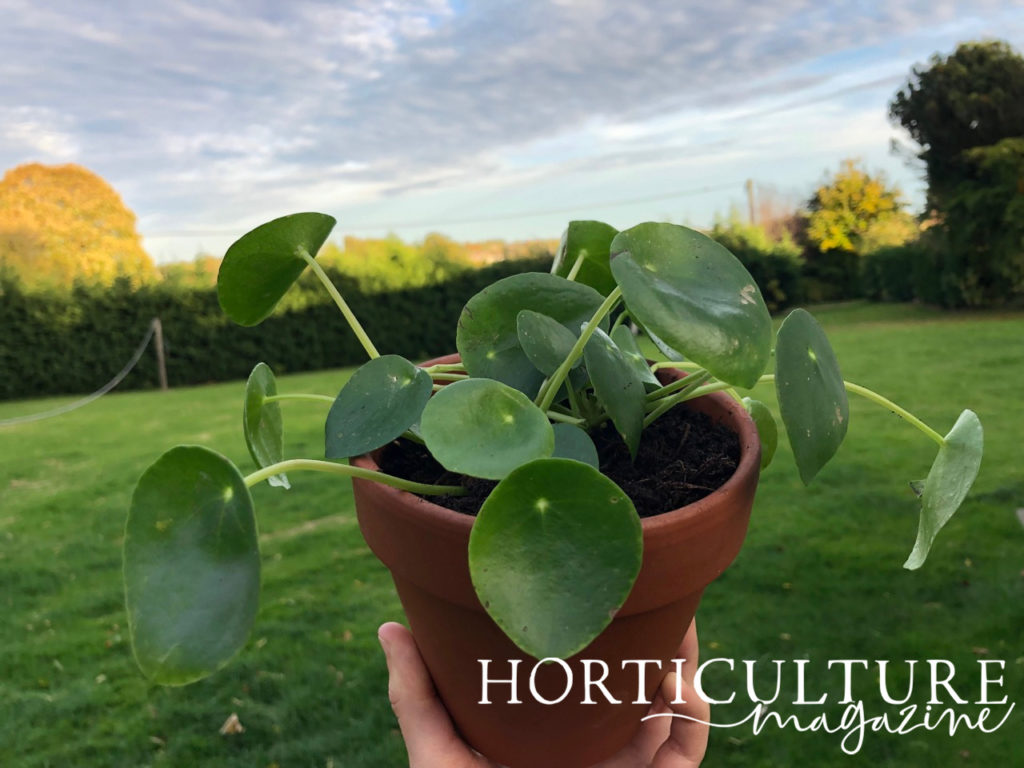
Though it may surprise you, in the 1980s it was determined that this plant is a member of the nettle family – Urticaceae.2Pilea peperomioides: Chinese Money Plant. (n.d.). Flowers of India. Retrieved March 22, 2023, from https://www.flowersofindia.net/catalog/slides/Chinese%20Money%20Plant.html
However, it was not previously all that widely known until social media brought it to greater prominence early this century.
Common Varieties
The species itself has been given an Award of Garden Merit by the RHS.
In recent years, a few named cultivars have emerged.
Three notable named cultivars of this species are ‘Mojito’, ‘Sugar’ and ‘White Splash’.
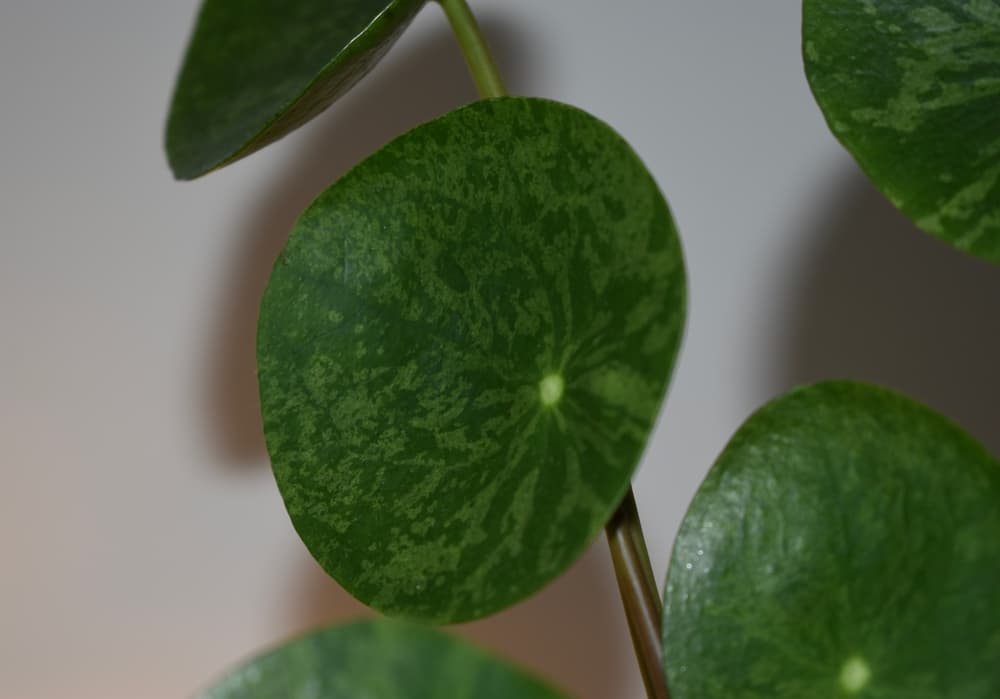
‘Mojito’ is a variegated variety which has pale green splashes on the usual smooth, fleshy green leaves.
‘Sugar’ is a beautiful varietal with white-speckled foliage and, as the name suggests, ‘White Splash’ has leaves that are splashed with white colouration.
Ongoing Plant Care
One of the reasons that this plant has been so popular with houseplant enthusiasts over the years is that although it looks quite unusual and exotic, it is actually a remarkably forgiving plant and is pretty easy to grow.
“Pilea peperomioides is a fantastic houseplant for beginners or children,” shares Master Horticulturist Colin Skelly.
“It looks exotic and feels like an achievement to grow, but will in fact tolerate less than favourable conditions rather well.
“In some of my more tricky houseplant positions, it will hang in there where most others will abandon hope.”
Light
The Chinese money plant prefers a bright location, but one that is out of direct sunlight during the hottest and brightest part of the day.
In winter, when growing indoors, it will do well in a bright room, though not in a south or west-facing window.
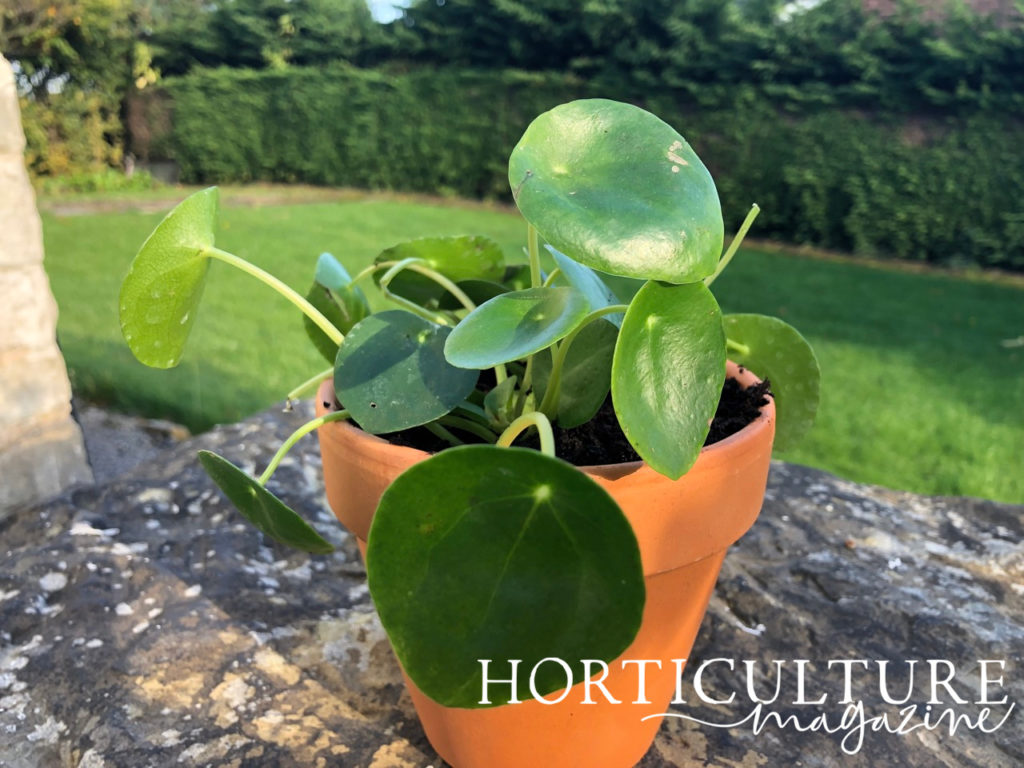
Outdoors (where it can be placed in summer) it prefers a very sheltered, mild and partially shaded spot.
The leaves will grow towards light, but turning your plant regularly will help to ensure that it does not end up with a lopsided appearance.
You should also make sure that you wipe the dust off the leaves now and then to ensure that they can continue to receive the light they need.
Humidity & Temperature
Pilea peperomioides does best when it is grown in a moderately humid environment and is misted occasionally where the air is very dry.
On the whole, however, misting won’t be essential most of the time in the UK, as the environment will be humid enough to satisfy the plant’s needs.

it is important to keep it somewhere where temperatures do not fall below 12°C.
This obviously means that your plant will need to be indoors in a heated space over the winter months, though it can potentially be placed outdoors in summer if you prefer not to keep it as a houseplant year-round.
Watering
This is a slightly succulent plant that likes well-drained conditions, so one of the most important things when caring for a Chinese money plant is to make sure that you provide the right amount of water.
Only water when the top few centimetres of the soil have begun to dry out; making sure that any excess water can drain away freely.
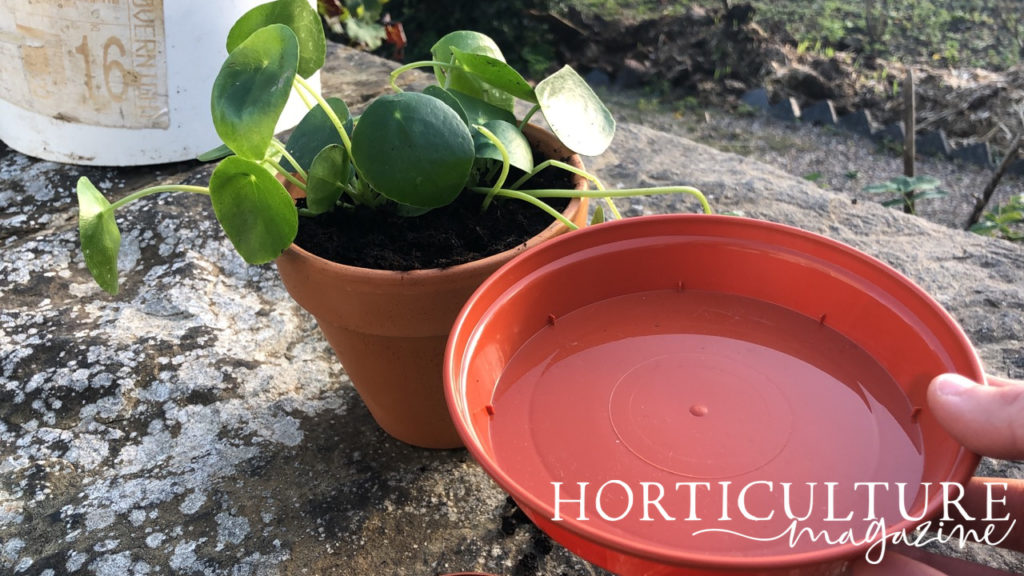
This plant can tolerate a lot but it cannot tolerate boggy, waterlogged conditions.
Remember, you will need to water houseplants in winter far less frequently than in the summer months.
So, reduce watering in response to the changing of the seasons.
Soil Requirements
I would recommend planting this species in a mix of rich peat-free, multipurpose compost or soil-based compost, with one-quarter perlite to help encourage drainage.
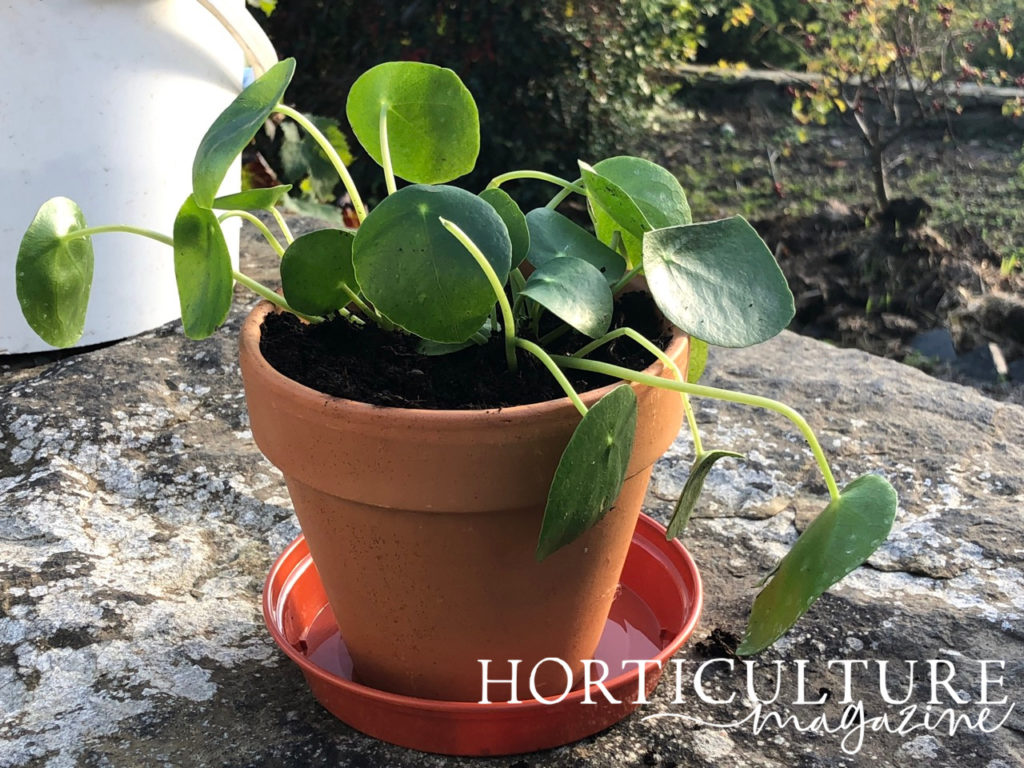
Whichever mix you choose, remember that creating free-draining conditions really is the most important thing when growing this plant successfully.
Fertilising
For optimal plant growth, it is best to feed this houseplant once a month with a weak organic houseplant feed or a homemade alternative like dilute compost tea.
Common Problems
The most common problems for Pilea peperomioides arise from issues with watering.
Both underwatering and overwatering can cause drooping, floppy foliage on these plants.
Taking a look at the growing medium should soon reveal which is the cause.
Sometimes, other environmental issues can cause problems too.
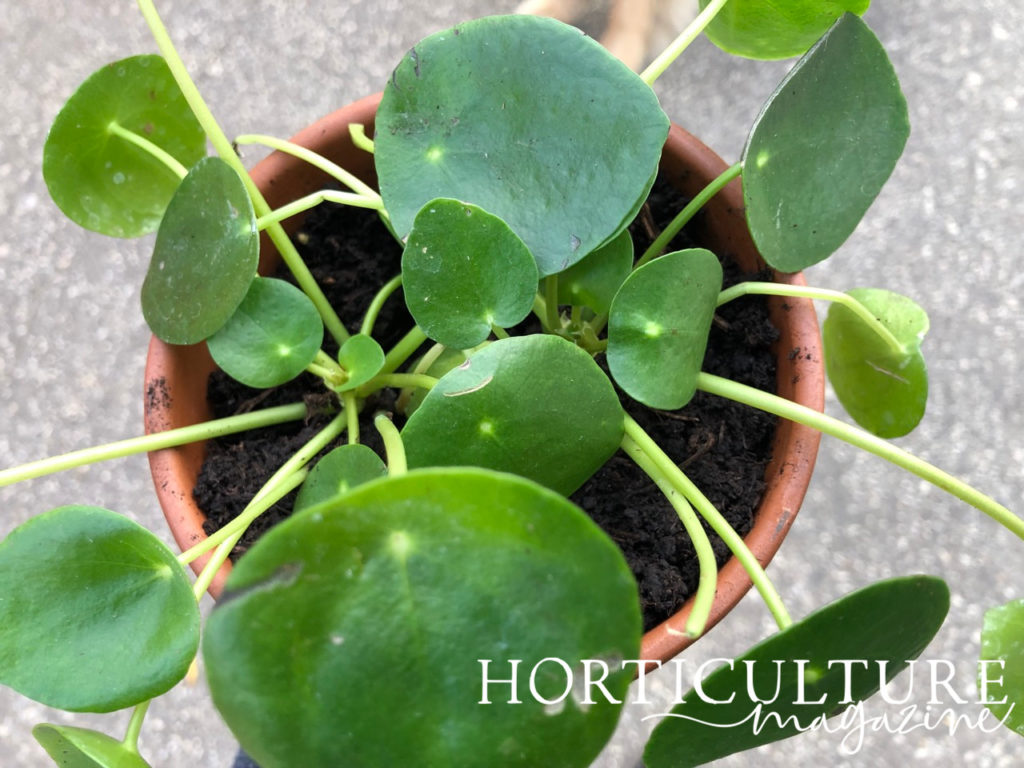
For example, too little light can cause leaves to curl, whereas too much light can cause pale leaves, and in direct sun, leaves may get sunburned and develop brown spots.
These plants can also suffer from scale insect infestation, which shows up, often, as brown lumps on the leaves.
Wiping these away can prevent issues from affecting the plant’s vigour.
Powdery mildew (a fungal issue) may also arise.
This causes white patches on the foliage. Ensure good airflow and ventilation, and remove affected leaves.
References
- 1Pilea peperomioides. (n.d.). Kew Royal Botanic Gardens. Retrieved March 22, 2023, from https://powo.science.kew.org/taxon/urn:lsid:ipni.org:names:855664-1
- 2Pilea peperomioides: Chinese Money Plant. (n.d.). Flowers of India. Retrieved March 22, 2023, from https://www.flowersofindia.net/catalog/slides/Chinese%20Money%20Plant.html
